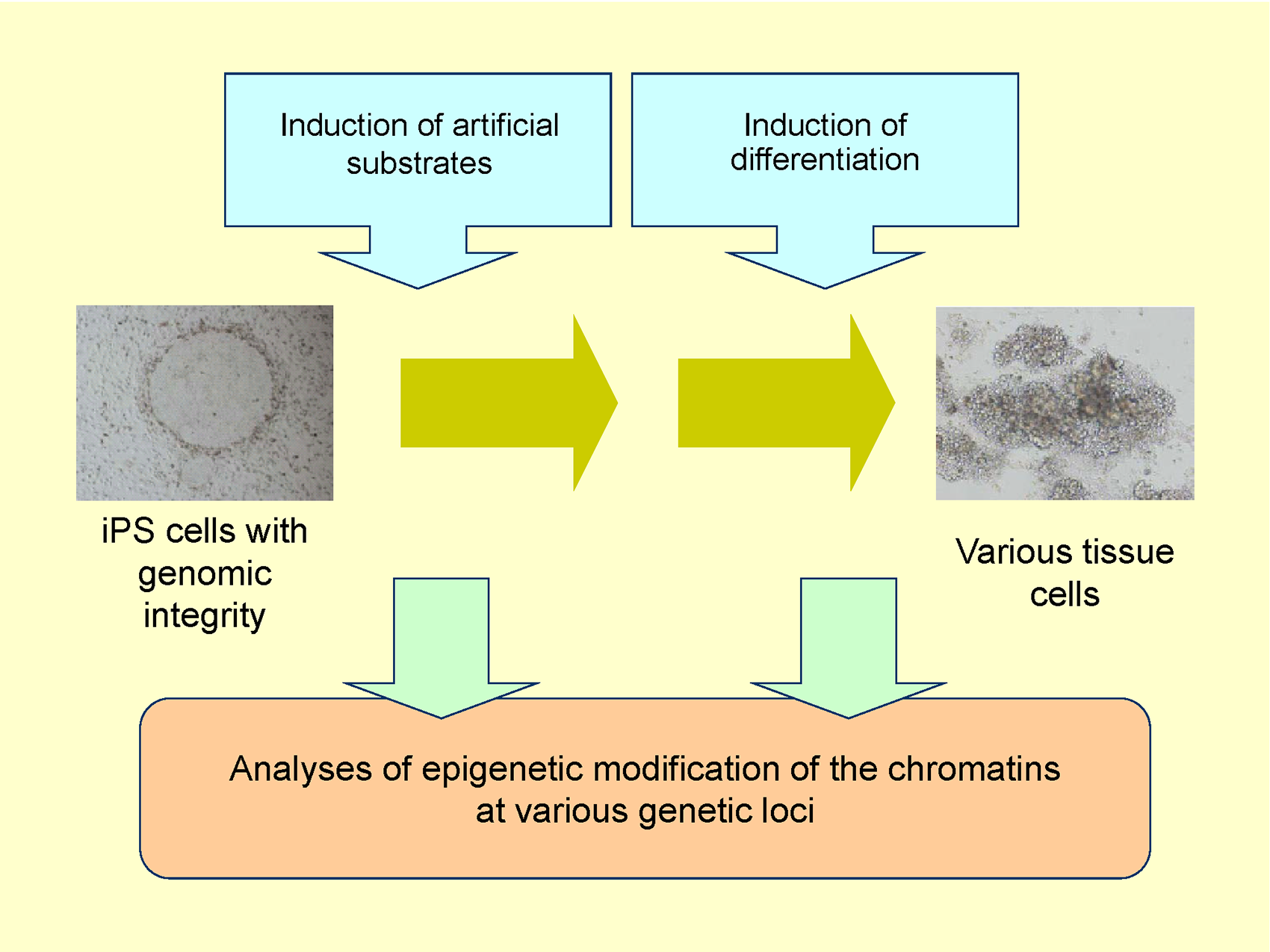プロジェクトのご紹介 13 - Project 13 -
細胞の分化と初期化に伴う染色体エピジェネティック修飾の解析
Analyses of epigenetic modification of chromosomes upon cell differentiation and reprogramming

特定の組み合わせの転写因子の遺伝子を導入することにより、体細胞がリプログラムされ、人工多能性幹細胞(iPS 細胞)が誘導される。
導入遺伝子の染色体への組み込みなしに高効率遺伝子導入が可能な非ウイルス的導入法を用いると、
ゲノムの完全性が保たれたiPS 細胞を樹立することが可能である。
我々はさらに、このようなiPS 細胞がさまざまな特異的な組織細胞に分化する機構を解析している。
とりわけ、さまざまな遺伝子座における、クロマチンのエピゲノム修飾が、細胞の分化とリプログラミングの制御に極めて重要な役割を果たしていると考えられ、これらの観点から解析を行っている。
Somatic cells can be reprogrammed into the inducible pluripotent stem cells (iPS cells) by transferring the genes encoding defined transcription factors.
Using non-viral gene transfer procedures that enable highly efficient transfection without chromosomal integration of the transgenes, it is possible to generate such iPS cells in which genomic integrity is maintained.
We are further analyzing the mechanisms by which these iPS cells give rise to various cells with tissue-specific characteristics.
Particularly, epigenetic modification of the chromatins at various genetic loci may play extremely important roles in the regulation of cell differentiation and reprogramming, so that we are currently exerting such analyses.
一部プロジェクトのご紹介 - See some projects among others -
- 新型コロナウイルス・オミクロン変異株に対する茶カテキン類の効果
Effects of tea catechin-related compounds on Omicron subvariants of SARS-CoV-2 - 腫瘍微小環境の低pHはプロトンセンサーGたんぱく共役レセプターをを介して腫瘍のPDL-1の発現を低下させる
Extracellular acidity in tumor tissue upregulates programmed cell death protein 1 expression on tumor cells via proton-sensing G protein-coupled receptors - 緑茶カテキン、カテキン誘導体、およびガレート型テアフラビンによる新型コロナウイルスの試験管内での有意な不活化;紅茶と緑茶による試験管内での唾液中の新型コロナウイルスの迅速な不活化
Significant Inactivation of SARS-CoV-2 by a Green Tea Catechin, a Catechin-derivative and Galloylated Theaflavins in vitro; Rapid Inactivation in vitro of SARS-CoV-2 in Saliva by Black Tea and Green Tea - 新規多孔性3Dスキャフォールドと直接誘導骨芽細胞を用いた骨再生
Nanogel tectonic porous 3D scaffold for direct reprogramming fibroblasts into osteoblasts and bone regeneration - TGFR阻害剤による骨芽細胞のケミカル・ダイレクト・リプログラミング
Chemical direct reprogramming of human fibroblasts into osteoblasts by a TGFR blockade - 筋芽細胞のダイレクト・リプログラミングと筋管形成
Direct reprogramming of functional myoblasts that are capable of forming multinuclear myotube - シュワン細胞のダイレクト・リプログラミングと末梢神経損傷の再生
Direct reprogramming of functional Schwann cells that promote regeneration of peripheral nerve - 褐色脂肪のダイレクト・リプログラミングと代謝疾患の制御
Direct reprogramming of functional brown adipocytes that control metabolic diseases - 骨芽細胞のダイレクト・リプログラミングと骨再生
Direct reprogramming of functional osteoblasts that regenerate bone tissue - IL-21 によるアレルギー応答の制御とその分子機構
IL-21-mediated regulation of allergic responses and its molecular mechanisms - IL-27 による NK 細胞活性化と ADCC を介した腫瘍抑制
IL-27 augments NK cytotoxicity and induces ADCC-based tumor suppression - EBV- エピゾーマルベクターによる外来遺伝子の高効率導入、高発現、長期間持続の機構解明
Mechanisms underlying the high-rate transfection, high-level expression, and long-term maintenance of exogenous genes mediated by the Epstein-Barr virus-based episomal vector - 細胞の分化と初期化に伴う染色体エピジェネティック修飾の解析
Analyses of epigenetic modification of chromosomes upon cell differentiation and reprogramming

